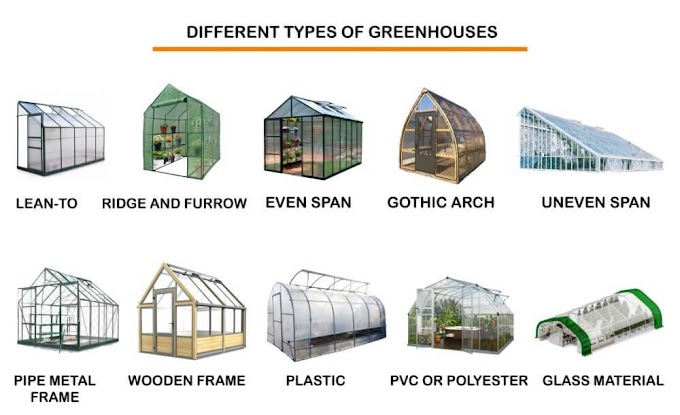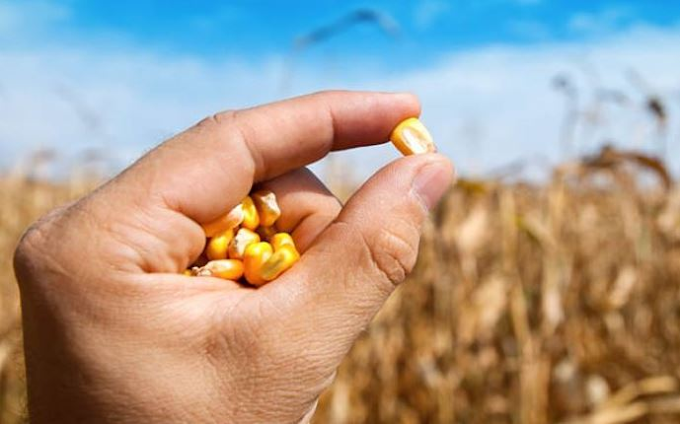Types of Green House
Greenhouse structures of various types are used successfully for crop production. Although there are advantages in each type for a particular application, in general there is no single type greenhouse, which can be considered as the best. Different types of greenhouses are designed to meet the specific needs.
Greenhouse type based on shape
Greenhouses can be classified based on their shape or style. For the purpose of classification, the uniqueness of the cross section of the greenhouses can be considered as a factor. As the longitudinal section tend to be approximately the same for all types, the longitudinal section of the greenhouse cannot be used for classification. The cross sections depict the width and height of the structure and the length is perpendicular to the plane of cross section. Also, the cross section provides information on the overall shape of the structural members, such as truss or hoop, which will be repeated on every day.
The commonly followed types of greenhouse based on shape are lean-to, even span, uneven span, ridge and furrow, saw tooth and quonset
Lean-to type greenhouse:
A lean-to design is used when a greenhouse is placed against the side of an existing building. It is built against a building, using the existing structure for one or more of its sides. It is usually attached to a house, but may be attached to other buildings. The roof of the building is extended with appropriate greenhouse covering material and the area is properly enclosed. It is typically facing south side. The lean-to type greenhouse is limited to single or double-row plant benches with a total width of 7 to 12 feet. It can be as long as the building it is attached to. It should face the best direction for adequate sun exposure. The advantage of the lean-to type greenhouse is that, it usually is close to available electricity, water, and heat. It is a least expensive structure. This design makes the best use of sunlight and minimizes the requirement of roof supports. It has the following disadvantages: limited space, limited light, limited ventilation and temperature control. The height of the supporting wall limits the potential size of the design. Temperature control is more difficult because the wall that the greenhouse is built on, may collect the sun's heat while the translucent cover of the greenhouse may lose heat rapidly. It is a half greenhouse, split along the peak of the roof.
Even span type greenhouse:
The even-span is the standard type and full-size structure, the two roof slopes are of equal pitch and width. This design is used for the greenhouse of small size, and it is constructed on level ground. It is attached to a house at one gable end. It can accommodate 2 or 3 rows of plant benches. The cost of an even-span greenhouse is more than the cost of a lean-to type, but it has greater flexibility in design and provides for more plants. Because of its size and greater amount of exposed glass area, the even-span will cost more to heat. The design has a better shape than a lean-to type for air circulation to maintain uniform temperatures during the winter heating season. A separate heating system is necessary unless the structure is very close to a heated building. It will house 2 side benches, 2 walks, and a wide center bench. Several single and multiple span types are available for use in various regions of India. For single span type the span in general, varies from 5 to 9 m, whereas the length is around 24 m. The height varies from 2.5 to 4.3 m.
Uneven span type greenhouse This type of greenhouse is constructed on hilly terrain. The roofs are of unequal width; make the structure adaptable to the side slopes of hill. This type of greenhouses is seldom used now-a-days as it is not adaptable for automation
Ridge and furrow type greenhouse:
Designs of this type use two or more A-frame greenhouses connected to one another along the length of the eave . The eave serves as furrow or gutter to carry rain and melted snow away. The side wall is eliminated between the greenhouses, which results in a structure with a single large interior, Consolidation of interior space reduces labour, lowers the cost of automation, improves personal management and reduces fuel consumption as there is less exposed wall area through which heat escapes. The snow loads must be taken into the frame specifications of these greenhouses since the snow cannot slide off the roofs as in case of individual free standing greenhouses, but melts away. In spite of snow loads, ridge and furrow greenhouses are effectively used in northern countries of Europe and in Canada and are well suited to the Indian conditions
Saw tooth type Greenhouse:
These are also similar to ridge and furrow type greenhouses except that, there is provision for natural ventilation in this type. Specific natural ventilation flow path develops in a saw- tooth type greenhouse.
Quonset greenhouse:
This is a greenhouse, where the pipe arches or trusses are supported by pipe purling running along the length of the greenhouse. In general, the covering material used for this type of greenhouses is polyethylene. Such greenhouses are typically less expensive than the gutter connected greenhouses and are useful when a small isolated cultural area is required. These houses are connected either in free, standing style or arranged in an interlocking ridge and furrow.
In the interlocking type, truss members overlap sufficiently to allow a bed of plants to grow between the overlapping portions of adjacent houses. A single large cultural space thus exists for a set of houses in this type, an arrangement that is better adapted to the automation and movement of labour
Greenhouse type based on utility
Classification of greenhouses can be made depending on the functions or utilities. Of the different utilities, artificial cooling and heating of the greenhouse are more expensive and elaborate. Hence based on the artificial cooling and heating, greenhouses are classified as green houses for active heating and active cooling system
Greenhouses for active heating:
During the night time, air temperature inside greenhouse decreases. To avoid the cold bite to plants due to freezing, some amount of heat has to be supplied. The requirements for heating greenhouse depend on the rate at which the heat is lost to the outside environment. Various methods are adopted to reduce the heat losses, viz., using double layer polyethylene, thermo pane glasses (Two layers of factory sealed glass with dead air space) or to use heating systems, such as unit heaters, central heat, radiant heat and solar heating system
Greenhouses for active cooling:
During summer season, it is desirable to reduce the temperatures of greenhouse than the ambient temperatures, for effective crop growth. Hence suitable modifications are made in the green house so that large volumes of cooled air is drawn into greenhouse, This type of greenhouse either consists of evaporative cooling pad with fan or fog cooling. This greenhouse is designed in such a way that it permits a roof opening of 40% and in some cases nearly 100%







No comments:
Post a Comment